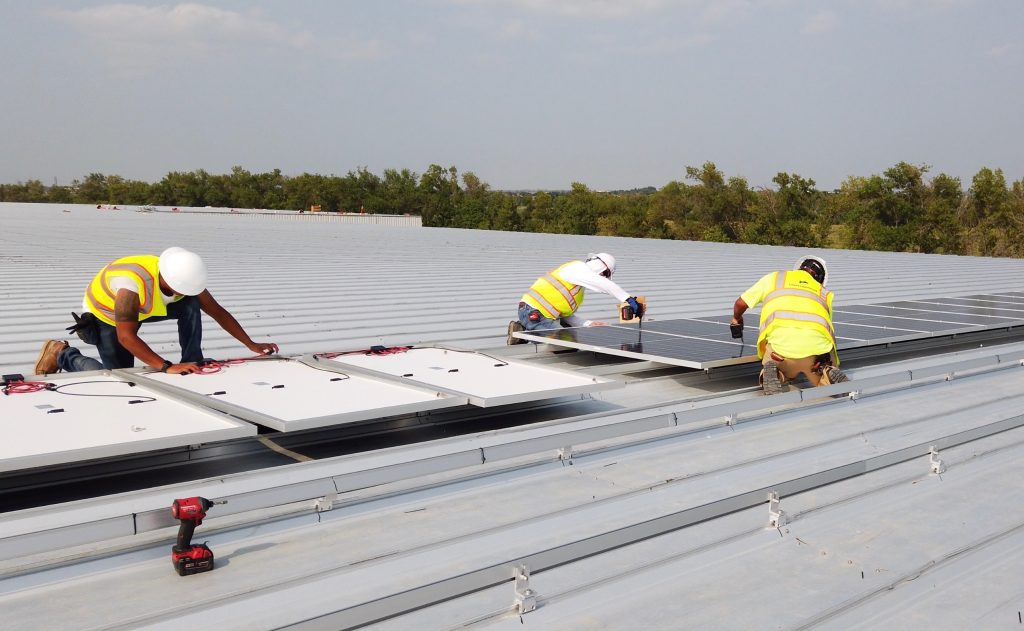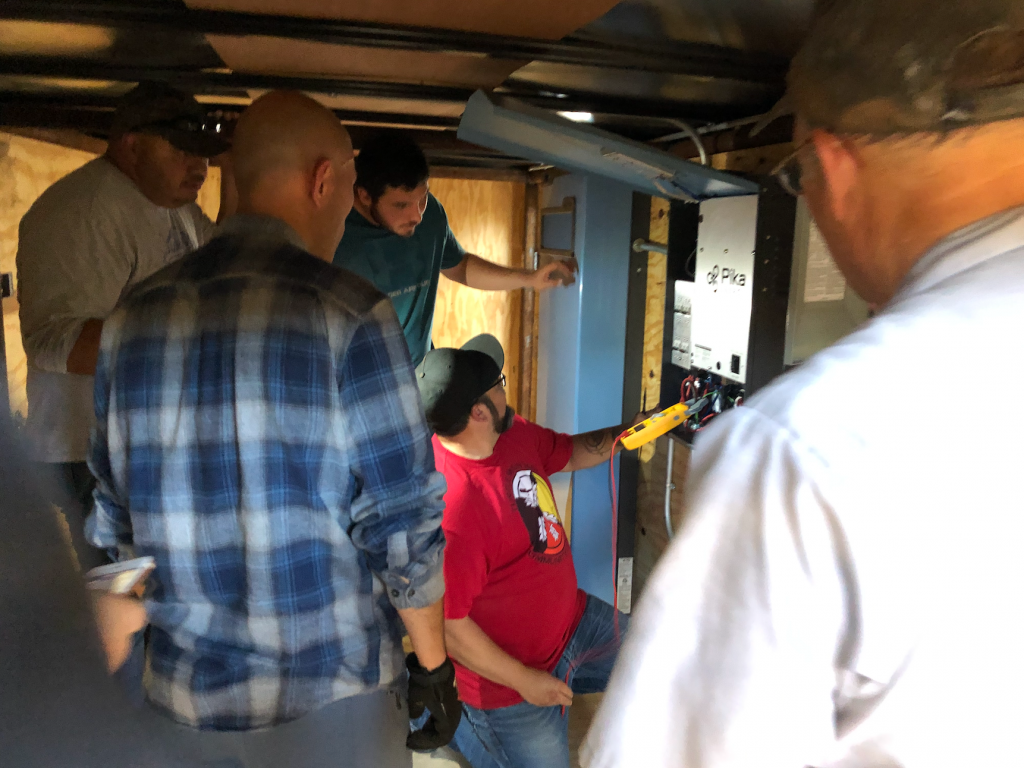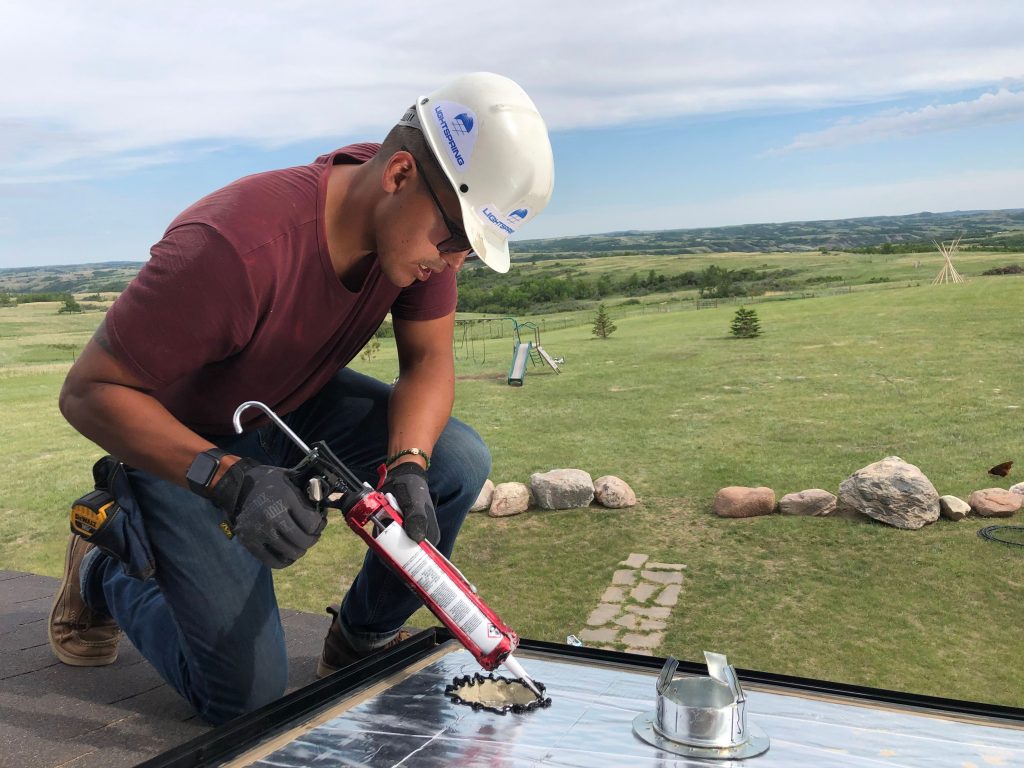In a state where oil is king, North Dakota’s tribal colleges are putting their bets on renewable energy.
By Melanie Lenart

North Dakota isn’t the first place that comes to mind for solar energy. Unlike the sunny Southwest, winters in this state bordering Canada can usher in temperatures as low as 40 below. In most years, more snow falls than rain, some of it in the form of blizzards.
Yet despite these cold-weather challenges, several tribal colleges in the state are successfully using solar power for their facilities—and training students and community members in their use along the way. The ongoing shift to renewable energy in tribal communities and colleges in the state is all the more impressive considering that oil drives North Dakota’s economy.
Turtle Mountain Community College in Belcourt is currently adding solar power to its impressive array of renewable energy technology. As well as being the first tribal college with its own wind power generator, this college at the northern edge of North Dakota also warms all its buildings, including classrooms, with geothermal energy by tapping into this source of heat below the surface. By adding solar to the mix, administrators hope to take another step toward sustainability at a college that already secures 80 percent of its energy, on average, from renewable sources.
Further south in the state, United Tribes Technical College is also getting into the solar action, hosting trainings in solar panel installation and operation in a collaboration between various entities including a local company called Lightspring. Meanwhile, Native Brother Services, a Native-owned energy firm based in Bismarck, has expanded its operations to include solar power, and will start training student apprentices from Nueta Hidatsa Sahnish College in New Town. Sitting Bull College, chartered by the Standing Rock Sioux Tribe, also offers a certificate in wind energy technology to complement the state’s largest solar array near this college.
Turtle Mountain tops off renewables with solar power
Turtle Mountain Community College Facilities Manager Wes Davis developed software so that the college’s geothermal and wind energy can work together to provide an average of 80 percent of the institution’s energy needs annually. By adding solar to its energy portfolio, Davis expects that percentage to rise to 90 percent or more. Using renewable energy reduces the need to tap into oil, coal and gas—the so-called fossil fuels ramping up climate change.
Davis shared some of his sustainable energy knowledge in the summer of 2019 with about two dozen community members through a hands-on program at United Tribes Technical College near Bismarck. The UTTC program culminated in the construction of a solar power trailer for the United Tribes annual Pow Wow.
“That teaching part is where my passion is now,” Davis said. “The only way to give something back—it’s not money, it’s not anything physical—it’s actually education. That’s how you can help your seventh generation.”

Davis understands the power of education from personal experience. When he started his associate degree in Heating, Ventilation and Air Conditioning (HVAC) from Northwest Technical College in Minnesota, he had self-described social anxieties and learning deficiencies. He credits instructor Chris Reak with making learning fun by teaching in an interactive and hands-on way. He and another mentor also helped Davis improve his communications skills.
Once Davis had his HVAC degree, he expanded into sustainable energy, initially by installing a geothermal system in the Minnesota mansion of a woman who trusted he would figure it out during the three months she gave him to do the job. He did, and that project led to others.
Word got out that a man who grew up on the Turtle Mountain Reservation—where TMCC is located—had experience with sustainable energy systems. In 2005, TMCC administrators recruited him to work on their “incredibly huge but incredibly inefficient” HVAC system.
Heating and cooling are key
Thanks to a forward-thinking Board of Trustees acting in the 1990s, Turtle Mountain Community College had built its 145,000 square feet institution with sustainability in mind, starting with geothermal. This approach taps into the heat stored below the Earth’s surface—a potential major savings, given that about half the energy used by a typical North Dakota institution goes for heating.
When he came on board, Davis spent three years getting to know the mechanical system producing and distributing the energy.
“I finally got all the bells tuned up, I got all the whistles sounding good, and the heat pumps operating,” Davis said. Of course, keeping things tuned up is an ongoing job, and he had just met with contractors regarding another state-of-the-art upgrade before talking with Native Science Report.
In those early days, he recognized that he needed to start by getting a computer program to help coordinate the various power sources and the backup generator so they would work seamlessly together. He developed software to help the pumps and other bells and whistles work efficiently together, incorporating wind energy from the new campus-based windmill in 2009.
With a few other investments and tuning through the years, he was able to slash the college’s $500,000 annual energy bill down to about $200,000.
“Not only can I give them a better learning environment, but I can also help them in other ways with the savings we have,” Davis said. “With our savings here, that goes back to the institution but it goes back to the students and the quality of life here at the institution.”
Savings helps support the community kitchen and a “hardship” fund that helps students in need of rides, groceries or day care. Davis also has plans to use some of the savings and geothermal heat to build greenhouses that can grow food year-round, thus improving the college’s food sovereignty.
Slicing the bill requires far more than maintaining equipment, he noted, partly because power companies charge the most for spikes of energy use. Davis analyzed the energy use patterns, noticing that extra heating tended to kick in around 7:30 or so in the morning, when students were arriving for classes. By setting the heat for 74 degrees beforehand, he found he could avoid the spike in energy used as the building struggled to maintain the typical 70-degree temperature. College administrators even switched to a four-day workweek of 10 hours per day during the summer to save about $8,000 seasonally on cooling.
For other tribes and tribal colleges seeking to “attain sovereignty through sustainable energy,” as he puts it, Davis note that the first step is to do a feasibility study. President Biden has made funding available to tribes and tribal colleges interested in taking this step.
Coaxing savings out of renewable energy takes time and effort, and there’s no replacement for a skilled person to stay on top of things. As for learning how to install and operate solar panels, though, Davis believes it would take most people just a few work sessions to get the hang of it.
Training students in solar
Coulee Luger, a co-owner of Native Brother Services, agreed that installing solar panels is something a person can learn to do with a few projects. He should know, as the five-person company helping families with their energy needs added solar to its repertoire about six months ago.
Already he has had the opportunity to work alongside Davis on an 80-kilowatt project secured by Lightspring, “collaborating as First Nations People and European Americans,” as the energy company’s website put it. The project involved installing solar panels on the roof of PRx Performance, a Fargo-based manufacturer of exercise equipment.
“It’s pretty straightforward with solar,” Luger said. “All of our guys were able to pick it up really quickly, including myself.”
That said, there are many other skills involved when assessing a property for renewable energy, and a whole other skill set when running a solar power business. Luger said his company will be starting a program this fall to teach some of these skills at nearby Nueta Hidatsa Sahnish College on the Fort Berthold Reservation.
“What we’re going to help the students do is actually walk them through the bid process too,” he explained. They’ll teach students how to size the solar system, determine what materials are needed to carry out the project, and even contact the relevant companies to obtain those materials. “The design of the solar project you’re doing takes more time than the installation,” Luger added. “But doing that with them will give them an idea of what goes into it as well.”
Davis similarly is working on curriculum for a summer program in renewable energy at TMMC, for students and also community members from the numerous tribes in North Dakota and beyond. Energy efficiency will be a training option in the 50,000-square-foot building TMCC is constructing for career and technical education trades.
“I just want to take everything I’ve learned in the last 20 years and give it back to not just tribal communities, but also poor communities and infrastructure developers throughout the United States and the world,” Davis said. “I’m starting a program here to where I can give all of that back and hopefully create business owners, facility managers, infrastructure development officers who have that sustainability background.”
Solar saves the day for company
Luger credited his company’s move to solar with helping to keep the business afloat during a pandemic that shut down oil production on the fields that employ so many local people, including many from his tribes, the Mandan and Hidatsa. Speaking by phone in early August, he noted he had just come from a job installing solar panels on a house located in the middle of oil fields on the Mandan, Hidatsa and Arikara Nation.
“When the pandemic hit, all drilling stopped on the reservation,” he said. “We’re very blessed. If it wasn’t for solar, I don’t know if we’d have a company right now.”
He also appreciates the timing because he’s sensing a shift toward a more sustainable form of energy than the oil extraction and tar-sand fracking that have propelled North Dakota to one of the nation’s top oil and gas producers, second only to Texas. “I’m excited about solar because I think we’re hitting it at a good time,” Luger said. “The transition is happening, I think.”

In fact, New Mexico may soon surpass North Dakota in oil production, partly because local oil companies are having a difficult time finding employees.
It’s unclear whether the lack of interested employees relates to the controversies around oil and gas. The emissions released by oil, coal and gas is fueling an overall global rise in temperature, which in turn leads to longer heat waves, stronger hurricanes and bigger wildfires, and drought and water supply issues, as reiterated in the latest report issued in early August by the international body known as the Intergovernmental Panel on Climate Change.
Investing in a better future
Along with contributing to the ongoing climate change, the production and transport of these fuels in pipelines threatens the air and waterways around them. During the same week that Davis and Coulee spoke with Native Science Report, an out-of-control fire involving three oil wells was entering its third week in western North Dakota.
In Bismarck that week, the fracking company Summit Midstream Partners agreed to pay $35 million for its negligence in the leak of 29 million gallons of water contaminated with salt and petroleum products into Blacktail Creek near Williston for more than five months during 2014-2015.
The risk in transporting products from fracking and oil production in pipelines under waterways became a nationwide concern in 2016, when the Standing Rock Sioux and other North Dakota tribes and their allies worked to halt the construction of the Dakota Access Pipeline through their tribal lands, under the crossing of the Missouri River. Opposition efforts stalled recently when a federal judge declined to shut down the pipeline during an environmental review by the Army Corps of Engineers, scheduled for completion in March of 2022. Once that review is complete, the case may likely return to the court, if either side challenges the results.
As the case wound through the courts, though, the site has become a shining example of the path away from fossil fuels such as oil, coal and gas. As Davis noted, Indigenized Energy launched in 2019 the largest solar farm in North Dakota at the site of the Standing Rock Sioux protests.
Nearby Sitting Bull College also has partnered with NASA to develop a Facility for Innovative Atmospheric Research and Education, which will provide useful data as well as research opportunities for students in its environmental science and other programs, including a new master’s degree in atmospheric science. Some of its alumni are involved in efforts to set up a 235-megawatt wind farm north of the college.
Meanwhile, the White Earth Nation of Ojibwe in neighboring Minnesota and allies are currently battling the construction of another pipeline, with a lawsuit challenging the right to use 5 billion gallons in groundwater for its construction.
The so-called Line 3 Enbridge pipeline aims to cross 22 rivers and 800 acres of wetlands on the reservation, and many more before it reaches its destination in Wisconsin, as opposition leader Winona LaDuke of White Earth explained on Democracy Now.
Alternative energy as good business
In another example of tribal entities and enterprises promoting alternatives to fossil fuel energy, LaDuke founded a company, 8th Fire Solar, with a variety of partners. In 2019, the company began manufacturing and distributing solar thermal panels. The panels feature a sheet of black chrome to absorb the sun’s rays sealed in a glass-covered panel that sits next to a home, with a fan blowing the resulting warm air into the home.
Even in a North Dakota winter, solar thermal systems can reduce propane heating costs by a third, said Luger, whose company incorporates solar thermal and energy efficiency as well as electricity-producing solar panels in its work.
He noted that the DAPL conflict was divisive among North Dakota tribal members, given that many indigenous people worked or owned companies linked to oil production. However, the situation seems less polarized now, he said, noting that his company is thriving by working with systems involving conventional petroleum products as well as renewable energy such as solar.
“I never thought I would say I’d be working with Winona LaDuke, but we do buy some of their solar panels,” Luger said. “The thermal collectors we buy are actually from the White Earth Nation in Minnesota.”
Luger was enthusiastic about the many projects currently underway, and unconcerned that the programs training tribal college students in solar power and other forms of sustainable energy might create competition for the company his grandfather started in 2014, Native Brother Services.
“It’s going to take a collective to make the sustainability happen,” he said. “It’s not going to take a couple of companies, it’s going to take a couple hundred companies to make that happen.”
• • •
Melanie Lenart is a regular contributor to Native Science Report and the author of a University of Arizona Press book called Life in the Hothouse: How a Living Planet Survives Climate Change
• • •
Enjoyed this story? Enter your email to receive notifications.
